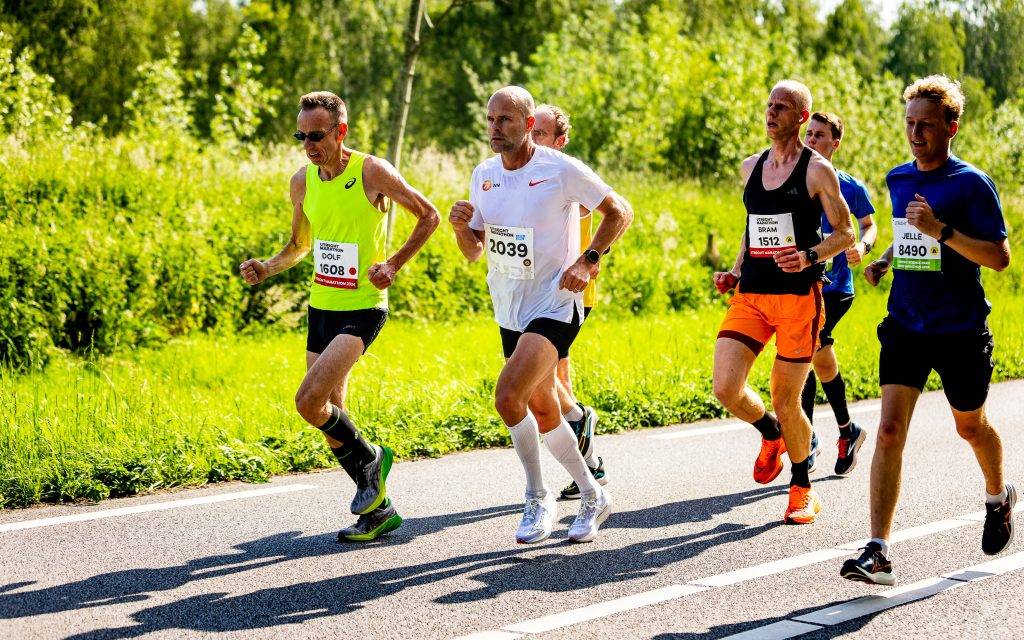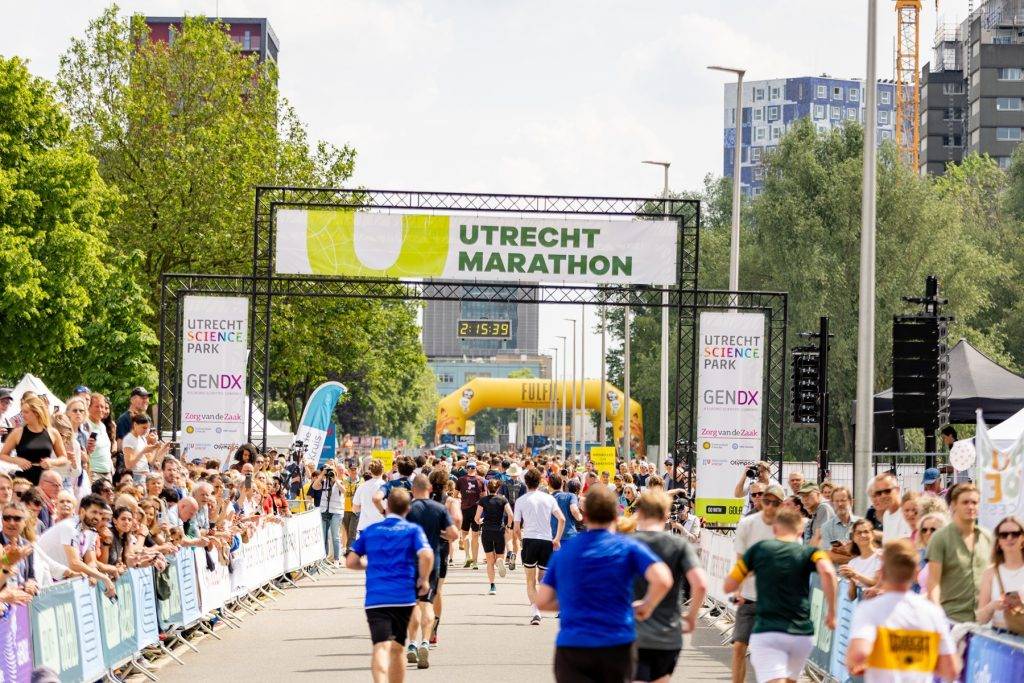Run responsibly
Good preparation is essential to participate responsibly in the Utrecht Marathon. In addition, it is important that you listen carefully to your body during and after your running performance. Read all the advice that will help you prepare well and enjoy the Utrecht Marathon below.
Preparations
A good preparation is essential to participate responsibly in the Utrecht Marathon. This preparation often starts weeks, if not months, before the start. View the important things during your preparation next to this.
Advices
If you have problems with your health that give you an increased risk of cardiovascular disease such as obesity, high blood pressure, high cholesterol, diabetes, previous cardiovascular disease (or common in the family) or if you often have injuries, we advise you to have a sports examination at a Sports Medical Advisory Agency (S.M.A.) or sports clinic.
On this (www.sportzorg.nl) website you can find more information about inspections, testing methods and possibly also complete a questionnaire (including a cardiovascular questionnaire). After completing this list, you can determine whether it makes sense for you to undergo a cardiovascular medical examination.
– Above 15 °C (and certainly 20 °C) you should dress in light, ventilated clothing, otherwise the body cannot lose the heat and there is a risk of heat build-up (note: no cotton, this retains moisture).
– In cold weather (5 °C and 10 °C for slower runners), a thermal shirt on the skin is the best choice. Wear a thin, ventilating layer (not nylon) on top of this. A hat is recommended when there is a low wind chill and wind.
Note: The slower your pace, the more clothing you will need (except in temperatures around 20°C). At a slower pace (walking), significant cooling occurs. The perceived temperature is mainly dependent on wind and humidity. When the temperature is +10°C with a moderate wind (approx. wind force 5), it feels like +4°C. However, if it is 5 °C with a moderate wind, it will feel like -4 °C. The temperature often drops by about 5 to 6 °C in the afternoon, causing many slower runners to cool down. Always tie your laces thoroughly with a double knot, so that they do not come loose during the match.
Make a running schedule tailored to the distance you are participating in.
Only run in well worn-in (note: never new!) shoes and socks and pay attention to the road surface during every training and competition. Alternate running left and right on the road when possible.
Do you have a febrile illness (> 38 °C) prior (approx. two weeks) to the event? Then don’t participate!

Before and during
The day of the event has arrived and you come to the start well prepared. For successful participation, it is important to take various factors into account just before and during the run. Read the advice below carefully so you don’t leave anything to chance.
The amount you drink depends individually on the weather and perspiration. Drink extra up to 45 minutes before the start, then stop drinking and visit the toilet. Take a bottle (approx. 300 ml) into the starting area and drink it 5 to 10 minutes before the start. This way you avoid having to pee on the go.
A feeling of thirst is never a good indicator. If you are not used to drinking, drink 100 to 200 ml of water every 15 minutes. Carbohydrate-containing drinks 5-8% are also suitable. Make sure you consume about 70 grams of carbohydrates per hour during the entire race. Bottles of measured sports drinks (on your belt) can help you with this.
In cool weather or for the slower runner, consume energy drinks instead of solid food or fruit. These stay in your stomach too long. The weight difference between before and after the run of more than 1 kg is equal to the amount of fluid you did not drink enough. So try this out during training.
If you don’t feel well, stop immediately. The first symptoms of dehydration are goosebumps on the chest and upper arms, chills, pressure in the head, dizziness, muscle cramps, vomiting and dry skin. These symptoms can quickly progress to disorientation and confusion.
If you have ever had problems with dehydration and/or too high a temperature, you have a greater chance of it happening again (especially in warm weather). Then don’t continue, there is no shame in dropping out!
If you have a calf cramp, walk slowly or walk and stretch lightly if necessary. Don’t stop, but drink extra. Beware of dehydration.
Start slowly and control your pace. Every second per kilometer too fast at the start of the race can result in a loss of minutes per kilometer at the end.
Run at your own pace and avoid pace increases and sprints in the last kilometers.
Discontinue if there is chest pain, abnormal shortness of breath and/or dizziness.
Pay close attention to the road surface and other situations around you.
Apply Vaseline to nipples, thighs and other chafing areas.
You must carry medical information about diseases (such as diabetes or medication) with you. Please state this on the back of your bib number. Also write down a telephone number of a contact person who can be reached during the race. Please also include your name, address and telephone number.
After the run
Immediately after the finish it is useful to drink plenty of fluids and eat enough carbohydrates to replenish fluid and energy losses. Sports drinks with carbohydrates, a large amount of water (approx. 500 ml) and bananas or other fruits are recommended.
Don’t eat too heavy a meal. Cool down well. In cold weather, dress up immediately and drink tea or broth if necessary. No alcoholic drinks or coffee!
You should also walk regularly in the days after your run, drink extra fluids and consume carbohydrate-rich products. Take enough time for recovery!
Urgent questions
Despite good preparation and reading the medical information, you still have urgent questions about training, injuries, nutrition, etc. If you have any questions, we advise you to contact your doctor.
Before and during
The organization’s medical team, consisting of doctors and specialized nurses, has been working for years with a written protocol for, among other things, the detection and treatment of heat stroke. This protocol is based on scientific research and is coordinated and shared with ambulance personnel, municipal emergency services and the Red Cross. Recognition and rapid treatment of heat stroke, among other things, are central. Potential victims are cared for in medical stations along the course and at the finish by specialist doctors and nurses.
The organization and its medical team know, based on scientific research, that a cooling bath is an adequate treatment method, but that with our medical protocol you can also be cooled very quickly and actively with ice and wet towels. However, in consultation with the medical committee, it was decided to supplement the existing medical protocol with a cooling bath at the finish that can be used if necessary.
There are several care and first aid stations along the way. If you need help or are unexpectedly unable to continue, walk at a leisurely pace to the next aid or sponge station. Here you will be welcomed by Red Cross or First Aid staff.
It is not possible to pick you up at random places along the route. In case of emergencies, a location has been set up immediately after the finish.

